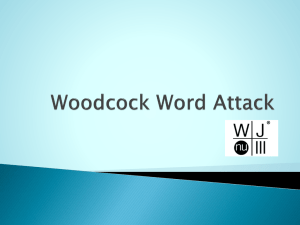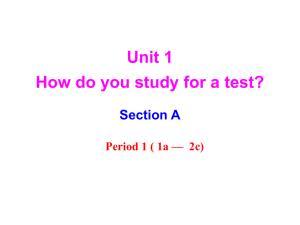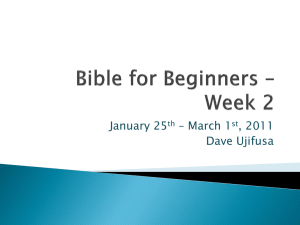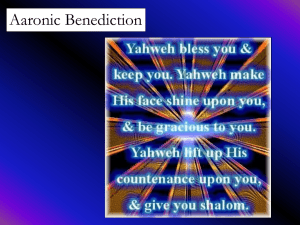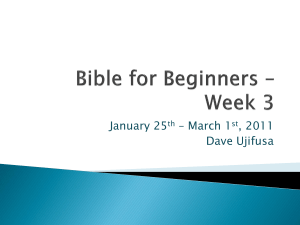PowerPoint File Format
advertisement
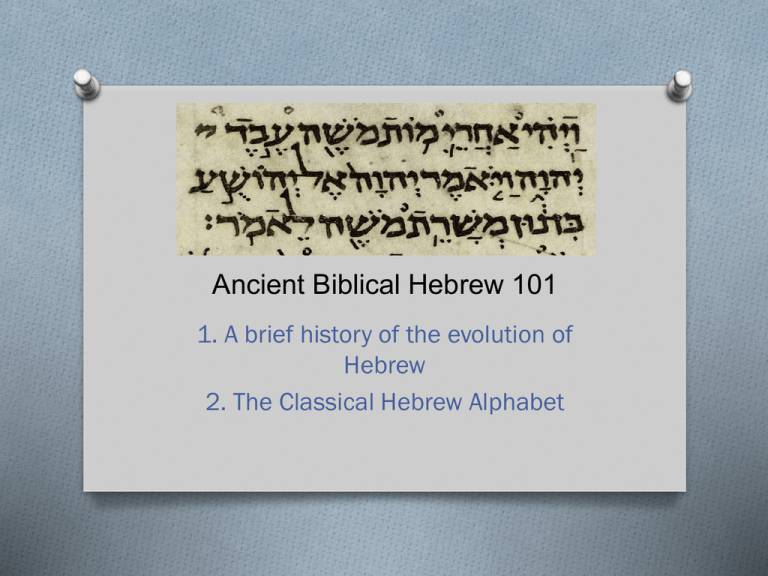
Ancient Biblical Hebrew 101 1. A brief history of the evolution of Hebrew 2. The Classical Hebrew Alphabet Zephaniah 3:8 Hebrew Text Evolution of the Hebrew Aleph Beth O Proto-Sinaitic/Proto-Canaanite (1800 BC) O Paleo Hebrew/Phoenician Script (1000 BC) O Aramaic Script (800 BC) O Masoretic Script (150 BC) O Modern Hebrew Block Script (late 1890s) Biblical Manuscripts (1/3) O King Solomon more than likely invented the Phoenician script, as during the “golden age” of Israel, he consolidated Israel, Phoenicia and Egypt as one conglomerate empire. O Ezra the Scribe is credited with developing the Aramaic script and began copying the Tanakh (Ezra 7:10-11). O Baruch the scribe and the prophet Jeremiah made copies of the Tanakh before the Babylonian captivity (Jer. 36:27-28). O Prior to this, generally only the kings wrote copies of the Torah, as they were required to (Deut. 17:18-19, 2 Kings 22:8, 2 Chr. 34:14). Biblical Manuscripts (2/3) Excavated in the 1970s, the “Silver Scrolls”, which contain the Aaronic Blessing (Num. 6:24-26), are the oldest existing fragments of Biblical manuscripts. Written in the Paleo Hebrew script, they are dated back to 700 BC. O In the Qumran caves, scant fragments from Genesis, Exodus, Leviticus, Numbers, Deuteronomy, Joshua and Job were found in the Paleo Hebrew script. O Biblical Manuscripts (3/3) The “Great Isaiah Scroll” is estimated by conservative calculations to be from 150 BC. The manuscript type is a transition from the Aramaic to the Masoretic script. O Like the Isaiah scroll, all other existing Biblical manuscripts – whether they be from the Dead Sea Scrolls or later manuscripts – are written in the Masoretic script. O Evolution of Hebrew Dialects 1/2 Classical Hebrew/Tiberian Hebrew The original, ancient pronunciation of Hebrew, spoken throughout the 1st Century AD by Yahshua and the Apostles, mainly in Galilee. “Tiberian” is named after the original Masoretic community in Tiberias. O “After these things Yahshua went over the sea of Galilee, which is the sea of Tiberias.” – John 6:1 Mishnaic / Tannaitic Hebrew / Early Rabbinic Hebrew Later Herodian Temple dialect of Hebrew that began to develop around 10 AD. Used in the rabbinical writings, such as the Mishnah, Gemara, Talmud, etc. More commonly spoken in Judea in the 1st Century AD than Galilee. O “…This fellow was also with Yahshua of Nazareth. And again he denied with an oath, I do not know the man. And after a while came unto him they that stood by, and said to Peter, Surely you also are one of them; for your speech betrays you. Then began he to curse and to swear, saying, I know not the man.” – Matthew 26:71-74 Evolution of Hebrew Dialects 2/2 Yemenite / Temani Hebrew Spoken by Mizrahi (“from the east”) or Middle Eastern Jewish communities, from Moroccans to Yemenites. Closest to the Tiberian dialect, more resembles Arabic. O Sephardic Hebrew Dialect spoken by communities from the Iberian Peninsula near Spain and Portugal. The dominant dialect for “Biblical Hebrew” classes and synagogue liturgy today. O Ashkenazi Hebrew Patterned after Yiddish or High Germanic, spoken by communities from central Europe. Ashkenazi make up the largest percentage (90%+) of Jewish demographics. O Israeli / Modern Hebrew Conversational form of Hebrew that was developed for the modern state of Israel. Dialect is patterned after Sephardic but borrows some grammar rules from Ashkenazi. O Word Example: “Sabbath” tbf@#$a O Classical / Tiberian: “Shab-bāth” (accent on last syllable) O Mishnaic: O Yemenite: O Sephardic: O Ashkenazi: O Israeli: “Shab-bāth” (accent on last syllable) “Shab-bāth” (accent on last syllable) “Shab-bāt” (accent on last syllable) “Shab-bös” (accent on first syllable) “Shab-bat” (accent on last syllable) Hebrew – The Source of All Languages O Paleo Hebrew/Phoenician (990 BC) O Koine Greek (400 BC) O Old Latin (75 BC) O Modern Latin/New Latin Alphabet (1375) W (Waw) vs. V (Vav) Controversy Prologue from Beowulf (Epic poem from 530 AD) O HWÆT, WE GAR-DEna in geardagum, þeodcyninga þrym gefrunon, hu ða æþelingas ellen fremedon! (Old English, 530 AD) O LO, praise of the prowess of people-kings of spear-armed Danes, in days long sped. (Modern English, 1550 AD) O Long ago, the Spear-Danes and their kings were a mighty people. We have all heard about their power and glory. (Late Modern English, 1775 AD) Tiberian vs. Modern Hebrew (1/5) “And I will make your windows of agates, and your gates of carbuncles, and all your borders of pleasant stones.” – Isaiah 54:12 CHETH DALETH QOPH ALEPH O The Hebrew word here is “eq-daħ” xd@Fq;)e O Modern Hebrew: “ek-dach” means “handgun”. CHET DALET KUF ALEF אקדח Tiberian vs. Modern Hebrew (2/5) “And the flax and the barley was smitten: for the barley was in the ear, and the flax was bolled.” – Exodus 9:31 VETH YOD VETH ALEPH O The Hebrew word bybi)f here is “ā-vīv” O “Aviv” is from the root word meaning to be tender, as in tender or brittle grain. It refers to stage of barley growth when the barley crop is golden to light brown, is tender enough to be roasted in fire (Leviticus 2:14) and would be crushed by hail. Immature barley that is green is rubbery and flexible, and would be resistant to the hail. Tiberian vs. Modern Hebrew (3/5) “And the flax and the barley was smitten: for the barley was in the ear, and the flax was bolled.” – Exodus 9:31 TAW O The Hebrew word LAMED YOD PHE ALEPH tloypi)j here is “ă-phī-lōth” O “Aphiloth” means “dark green”. The flax was “bolled” or had flowers budding, so it was harvest ready like the barley. Hence, the flax crop was destroyed, as well. Tiberian vs. Modern Hebrew (4/5) In Modern Hebrew, “aviv” means green, “Tel Aviv” ( )תל אביבmeans “mound of green” or “spring hill”. VET YOD VET ALEF אביב Conversely, in Modern Hebrew, “aphilot” means dark black or dusk, as in the black of night. TAV LAMED YOD PHE ALEF אפילת No, I AM Aphiloth, as my cape is black like the night! MWA HA HA HA! Hey, I’m NOT Aviv, I’m Aphiloth! Tiberian vs. Modern Hebrew (5/5) The proper pronunciation for “Zion” is “Tsiyon” (s̴ īy-yôn). NUN WAW YOD TSADI NwOy%ci O In Modern Hebrew, spelling “Tsiyon” with a “Z” letter (z Zayin) instead of a “TS” letter (c Tsadi) produces “ziyyon” – which is the f-word (“f**k”). NUN VAV YOD ZAYIN זיון Tiberian vs. Mishnaic Hebrew (1/3) In Leviticus 16, which describes the Yom Kippur rituals, the word “scapegoat” is translated from the Hebrew word “ă-zā-zēl”. The High Priest would cast lots – one for the scapegoat and one for the sin offering goat or lamb. LAMED ZAYIN ALEPH ZAYIN AYIN lziI)zF(j The High Priest would then lay hands on the scapegoat and transfer the sins of Israel onto the scapegoat, who would then be sent to wander to and fro the wilderness. “Ez” (z() refers to a goat and “azal” (lz)) means “to wander to and fro” or to depart or leave. Therefore, “azael” means “goat of departure”. As for the sin offering goat or lamb, his blood would be sprinkled on the mercy seat of the ark of the covenant and on the vail of the Holy of Holies. Evidently, the sin offering goat is a shadow picture of Yahshua, as when His blood atoned for our sins and mercy was shown, the Temple vail was rent. The scapegoat, to whom all sin is ascribed or blamed, is sent “to wander to and fro”, like HaSatan (Job 1:7, 2:2). Since the scapegoat is not killed, he is given the opportunity to return again to tempt the camp or congregation. Tiberian vs. Mishnaic Hebrew (2/3) In Mishnaic or Talmudic Hebrew, “azazel” (lz)z() is interpreted as follows – “el” (l)) means “power” or “strength” and “azaz” (zz() refers to a rugged cliff. This gave rise to the rabbinical tradition that the “azazel” scapegoat was pushed off a cliff on Yom Kippur. Help! The devil made me do it! Shut up, you know everything is your fault. “Not giving heed to Jewish fables, and commandments of men, that turn from the truth.” – Titus 1:14 Tiberian vs. Mishnaic Hebrew (3/3) “And he sent young men of the children of Israel, which offered burnt offerings, and sacrificed peace offerings of oxen unto YHWH.” – Exodus 24:5 In the Masoretic Text, the Hebrew word for “young men” is “na-ă-rīy”. In a copy of the Mishnah for Exodus (a rabbinical commentary) dated back to 60 AD, the Mishnaic Hebrew word for “young men” is “za-ă-tô-tëy”. YOD RESH AYIN NUN YOD TET WAW TET AYIN ZAYIN yrI(jna y+iIwO+(jza “na-ă-rīy” VS. “za-ă-tô-tëy” Resources on Hebrew Language History O A History of the Hebrew Language by Eduard Kutscher O The Schizoid Nature of Modern Hebrew: A Slavic Language in Search of a Semitic Past by Paul Wexler O History of the Modern and Ancient Hebrew Language by David Steinberg (free e-book) Resources on Biblical Hebrew O Gesenius’ Hebrew Grammar by Wilhelm Gesenius O Tiberian Hebrew Phonology by Andries W. Coetzee O An Introduction to Biblical Hebrew Syntax by Bruce K. Waltke & M. O’Conor O Hebraic Tongue Restored by Fabre d'Olivet International Phonetic Alphabet (IPA) ) 1. ALEPH O Pronunciation: Guttural vowel sound, a glottal stop like the hyphen in "uh-oh." O IPA Symbol: ʔ Glottal stop O Transliteration: Varies, depends on niqqud (vowel pointing) used with the Aleph. O Modern Pronunciation: Silent I will NOT be silenced. b@ 2. BETH (with dagesh) O Pronunciation: “B” as in “boy”. O IPA Symbol: b Voiced bilabial stop (plosive) O Transliteration: B O Modern Pronunciation: Same but spelled “Bet” b 2. VETH (no dagesh) O Pronunciation: Humming "V" sound, made by vibrating both lips without the lips touching the front teeth. O IPA Symbol: β Voiced bilabial fricative O Transliteration: V O Modern Pronunciation: "V” as in "valley," like an English "V" with the bottom lip touching the front teeth, spelled “Vet”. g% 3. GIMEL (with dagesh) O Pronunciation: “G” as in “get”. O IPA Symbol: g Voiced velar stop (plosive) O Transliteration: G O Modern Pronunciation: Same g 3. GHIMEL (no dagesh) O Pronunciation: Put your tongue on the same part of the roof of your mouth where a “G” is pronounced, but hover your tongue instead of touching the palate. Make a cross between a “G” and an “H” sound, like having cotton candy stuck in your mouth. O IPA Symbol: ɣ Voiced velar fricative O Transliteration: Gh O Modern Pronunciation: Same as Gimel g%, dagesh is ignored. d@ 4. DALETH (with dagesh) O Pronunciation: “D” as in “door”. O IPA Symbol: d Voiced dental stop (plosive) O Transliteration: D O Modern Pronunciation: Same but spelled “Dalet” d 4. DHALETH (no dagesh) O Pronunciation: Buzzing "TH" sound as in "this” or “that”. Made by touching the tip of the tongue to the front upper teeth while exhaling. O IPA Symbol: ð Voiced dental fricative O Transliteration: Dh O Modern Pronunciation: Same as Daleth d@, dagesh is ignored. h 5. HE O Pronunciation: “H” as in “help”. O IPA Symbol: ɦ Voiced glottal fricative (breathy) O Transliteration: H O Modern Pronunciation: Same w 6. Waw O Pronunciation: “W” as in “wheel”. O IPA Symbol: w Voiced labio-velar approximant O Transliteration: W O Modern Pronunciation: V sound, spelled “Vav”, same as Vet b@. z 7. Zayin O Pronunciation: "Z" sound as in "zebra," but with a slight buzz before it to create a "DZ" sound. Accentuate the "Z" sound so that it is emphasized more then the "D" sound. O IPA Symbol: d͡ z Voiced alveolar sibilant affricate O Transliteration: Z O Modern Pronunciation: Plain “Z” as in “zipper” x 8. Cheth O Pronunciation: A deeper, more forceful or exasperated "H" sound. Sharply exhale an "H" sound while constricting the muscles in the back of the throat. Similar to the sound that is made when exhaling on a pair of glasses while cleaning them. O IPA Symbol: ħ Voiceless pharyngeal fricative O Transliteration: Ch O Modern Pronunciation: A throat clearing "CH" sound, like a German “Bach”, spelled “Chet”. + 9. Teth O Pronunciation: A cross between a "T" and a "D" sound. Made by touching the tip of the tongue to the roof of the mouth. Extend the tongue slightly further back while elevating the tongue. Lower the tip of the tongue, then curve it while making a sharp "T" sound. O IPA Symbol: t̪ ˤ Voiceless pharyngeal alveolar stop (Pharyngeal “T”) O Transliteration: T O Modern Pronunciation: Plain “T” as in “tango”, spelled “Tet” y 10. Yod O Pronunciation: “Y” as in “your” O IPA Symbol: j Palatal approximate O Transliteration: Y O Modern Pronunciation: Same k@ 11. Kaph K@ (sofit) Pronunciation: (with dagesh) O “K” as in “kour” O IPA Symbol: k voiceless velar stop (plosive) O Transliteration: K O Modern Pronunciation: Same k 11. Khaph (no dagesh) K(sofit) O Pronunciation: A throat clearing "CH" sound, like a German "Bach." O IPA Symbol: χ voiceless velar fricative O Transliteration: Kh O Modern Pronunciation: Same, in Modern Hebrew, the Khaph k is pronounced the same as Chet x. l 12. Lamed O Pronunciation: “L” as in “love” O IPA Symbol: l alveolar lateral approximate O Transliteration: L O Modern Pronunciation: Same m 13. Mem M O Pronunciation: “M” as in “mother” O IPA Symbol: m bilabial nasal O Transliteration: M O Modern Pronunciation: Same (sofit) n 14. Nun N O Pronunciation: “N” as in “never” O IPA Symbol: n alveolar nasal O Transliteration: N O Modern Pronunciation: Same (sofit) s 15. Samekh O Pronunciation: “S” as in “salvation” O IPA Symbol: s voiceless alveolar sibilant O Transliteration: S O Modern Pronunciation: Same ( 16. AYIN O Pronunciation: Guttural vowel sound, made while exhaling sharply and constricting the throat muscles. Similar to the sound a patient is asked to make when a doctor puts a wooden stick on their tongue (i.e., open wide and say "AAH"). O IPA Symbol: ʕ Voiced pharyngeal fricative O Transliteration: Varies, depends on niqqud (vowel pointing) used with the Aleph. O Modern Pronunciation: Silent They tried to silence me, too, bro. p%@ 17. Pe P% (sofit) Pronunciation: (with dagesh) O “P” as in “pepper” O IPA Symbol: p voiceless bilabial stop (plosive) O Transliteration: P O Modern Pronunciation: Same p 17. Phe (no dagesh) P(sofit) O Pronunciation: A soft "F" sound, as in "fine." Made by only using the lips and not touching the front teeth. Similar to blowing out candles with mild pressure. O IPA Symbol: ɸ voiceless bilabial fricative O Transliteration: Ph O Modern Pronunciation: "F” as in "for." Like an English "F," with the bottom lip touching the front teeth. c 18. Tsadi C(sofit) O Pronunciation: A "TS" sound, as in "pants," but with a slight hiss. Elevate the tongue while lowering the tip of the tongue. Place the tongue a little further back than the spot where an "S" sound is made. Curve the tongue like in the shape of a scoop and then make a "TS" sound. O IPA Symbol: s̴ nasal voiceless alveolar sibilant O Transliteration: Ts O Modern Pronunciation: Same q 19. Qoph O Pronunciation: A dry sound that is a cross between a hard "G" sound, as in "good," and a "K" sound, as in "kitchen." It is a deep sound made in the back of the throat. Similar to a clicking "Q" sound with a slight "ooh" at the end, like "qooh," as in "Kumar." O IPA Symbol: q voiceless uvular stop O Transliteration: Q O Modern Pronunciation: “K” as in “kite”, same as k@ in Modern Hebrew, spelled “Kuf” or “Kof”. r 20. Resh O Pronunciation: slightly rolled “r”, as in Portuguese “carro”. Made by gently rolling the tip of the tongue on the upper front teeth. O IPA Symbol: r alveolar trill O Transliteration: R O Modern Pronunciation: ʀ Uvular trill, an excessively rolled “r” like a French “rrr.” #$ 21. Shin O Pronunciation: “SH” as in “shore”. O IPA Symbol: ʃ voiceless palato-alveolar sibilant O Transliteration: Sh O Modern Pronunciation: Same #o 21. Sin (dagesh in upper left corner) O Pronunciation: sharper, “hissing”, more sibilant “s” sound. Examples: Polish or Russian “śruba”. Portuguese “mexendo”. Mandarin Chinese: “Xi’an dynasty”. Put your tongue between your teeth and hiss, it is like someone trying to whistle and failing miserably. O IPA Symbol: ɕ voiceless alveolo-palatal sibilant ś s with acute accent O Transliteration: S O Modern Pronunciation: Plain “s” sound, in Modern Hebrew, same as s Samekh. t@ 22. TAW (with dagesh) O Pronunciation: Sharp "T" sound, as in "teach." Made while the tongue is touching the back of the front upper teeth while exerting slight pressure. Make a sharp "T" sound while exhaling slightly. Avoid an excessively breathy pronunciation. O IPA Symbol: t̪ voiceless dental stop (plosive) O Transliteration: T O Modern Pronunciation: Plain “t” as in “tango”, in Modern Hebrew, same as + Tet. t 22. THAW (no dagesh) O Pronunciation: “TH” as in “throw” or “moth” O IPA Symbol: θ voiceless dental fricative O Transliteration: Th O Modern Pronunciation: Same as Tav t@, dagesh is ignored. TIBERIAN ALEPH BETH h d d@ g g% b b@ ) HE DHALETH DALETH GHIMEL GIMEL VETH BETH ALEPH l k k@ y + x z w LAMED KHAPH KAPH YOD TETH CHETH ZAYIN WAW q c p p% ( s n m QOPH TSADI PHE PE AYIN SAMEKH NUN MEM t t@ #o #$ r THAW TAW SIN SHIN RESH
